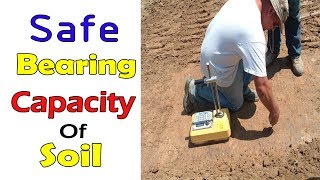
What Is The Safe Bearing Capacity Values For Different Soils?
The bearing capacity of soil is the ability of the soil to support the load from a structure without undergoing excessive settlement, deformation, or failure.
It's an important factor to consider when designing and constructing any type of foundation, be it for a building, bridge, or any other structure.
The safe bearing capacity of soil varies depending on the type of soil and its properties. And it will affect the type of foundation, which in turn will determine the cost of construction. We have provided you with a table that will summarize everything for you.
|
S.No |
Type of Soil |
Safe Bearing Capacity ( kN/m2) |
|
Cohesive Soils |
||
|
1. |
Soft shale, hard or stiff clay in a deep bed, dry state |
440 |
|
2. |
Medium clay readily indented with a thumbnail |
245 |
|
3. |
Moist clay and Sand clay mixture, which can be indented by thumb pressure |
150 |
|
4. |
Black cotton soil/expansive clay ( 50% saturated) in the dry state |
130 to 160 |
|
5. |
Soft clay indented with moderate thumb pressure |
100 |
|
6. |
Very soft clay which can be penetrated with a thump up to a few centimeters |
50 |
|
Cohesionless Soil |
||
|
7. |
Compact gravel/sand and gravel mixture with good resistance against penetration of tools |
440 |
|
8. |
Compact and dry coarse sand |
440 |
|
9. |
Compact and dry medium sand |
245 |
|
10. |
Loose gravel or sandy gravel mixture, dry state |
245 |
|
11. |
Fine sand and silt ( consists of dry lumps) |
150 |
|
12. |
Loose and dry fine sand |
100 |
|
Rocks |
||
|
13. |
Hard rocks such as granite trap, diorite, etc. |
3240 |
|
14. |
Laminated rocks such as sandstone, limestone, etc. |
1620 |
|
15. |
Residual deposits of shattered and broken bedrock and hard shale-cemented material |
880 |
|
16. |
Soft rocks |
440 |





